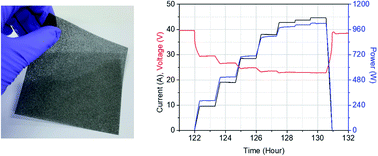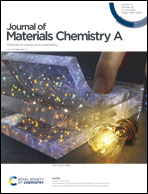Construction of high-temperature electronic conduction paths for the scale-up of solid oxide fuel cell technology†
Abstract
Solid oxide fuel cells (SOFCs) currently face great opportunities in various applications. One of the critical issues for their commercialization involves cathode current collection in full-scale stacks because forming a reliable electronic conduction path in high-temperature oxidizing environments is extremely difficult. Herein, we present a Cu–Mn foam as a highly efficient, reliable, and cost-competitive cathode current collector. The Cu–Mn foam exists as a metallic alloy in the as-fabricated state, which offers adequate mechanical properties for stack assembly. Subsequently, it transforms into a conductive spinel oxide during high-temperature operation, providing the desired electrical and structural characteristics. Resistance measurements at 700 °C verify that the Cu–Mn foam was stable for 27 000 h. In unit cell testing, the foam performs comparably to a noble metal (Pt) mesh, and when the cell is enlarged from 4 to 100 cm2, no performance loss occurs. Furthermore, it is successfully incorporated into a 1 kW-class full-size stack, where it demonstrates excellent durability in accelerated tests involving thermal and current cycling for 3684 h. This developed Cu–Mn foam can overcome a crucial limitation in the scale-up of SOFC technology and can also be utilized to construct high-temperature electronic conduction paths in various applications.



 Please wait while we load your content...
Please wait while we load your content...